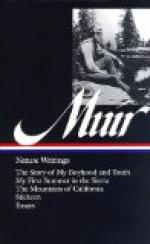After attaining the manly, belligerent age of five or six years, very few of my schooldays passed without a fist fight, and half a dozen was no uncommon number. When any classmate of our own age questioned our rank and standing as fighters, we always made haste to settle the matter at a quiet place on the Davel Brae. To be a “gude fechter” was our highest ambition, our dearest aim in life in or out of school. To be a good scholar was a secondary consideration, though we tried hard to hold high places in our classes and gloried in being Dux. We fairly reveled in the battle stories of glorious William Wallace and Robert the Bruce, with which every breath of Scotch air is saturated, and of course we were all going to be soldiers. On the Davel Brae battleground we often managed to bring on something like real war, greatly more exciting than personal combat. Choosing leaders, we divided into two armies. In winter damp snow furnished plenty of ammunition to make the thing serious, and in summer sand and grass sods. Cheering and shouting some battle-cry such as “Bannockburn! Bannockburn! Scotland forever! The Last War in India!” we were led bravely on. For heavy battery work we stuffed our Scotch blue bonnets with snow and sand, sometimes mixed with gravel, and fired them at each other as cannon-balls.
Of course we always looked eagerly forward to vacation days and thought them slow in coming. Old Mungo Siddons gave us a lot of gooseberries or currants and wished us a happy time. Some sort of special closing-exercises—singing, recitations, etc.—celebrated the great day, but I remember only the berries, freedom from school work, and opportunities for run-away rambles in the fields and along the wave-beaten seashore.




